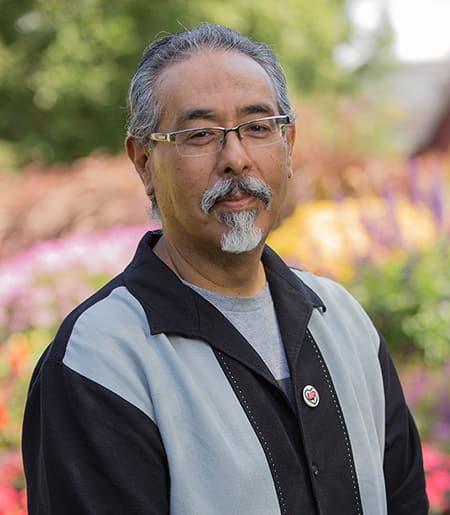Overview
Ricardo Dominguez is a co-founder of The Electronic Disturbance Theater (EDT), a group who developed virtual sit-in technologies in solidarity with the Zapatistas communities in Chiapas, Mexico, in 1998. His recent Electronic Disturbance Theater 2.0/b.a.n.g. lab project (http://tbt.tome.press/) with Brett Stalbaum, Micha Cardenas, Amy Sara Carroll, and Elle Mehrmand, the Transborder Immigrant Tool (a GPS cell phone safety net tool for crossing the Mexico/US border) was the winner of “Transnational Communities Award” (2008), an award funded by Cultural Contact, Endowment for Culture Mexico–US and handed out by the US Embassy in Mexico. It also was funded by CALIT2 and the UCSD Center for the Humanities. The Transborder Immigrant Tool has been exhibited at the 2010 California Biennial (OCMA), Toronto Free Gallery, Canada (2011), The Van Abbemuseum, Netherlands (2013), ZKM, Germany (2013), as well as a number of other national and international venues. The project was also under investigation by the US Congress in 2009-2010 and was reviewed by Glenn Beck in 2010 as a gesture that potentially “dissolved” the U.S. border with its poetry. Dominguez is Associate Professor of Visual Arts at the University of California, San Diego, a Hellman Fellow, and Principal/Principle Investigator at CALIT2/QI, UCSD. He also is co-founder of *particle group*, with artists Diane Ludin, Nina Waisman, Amy Sara Carroll, whose art project about nano-toxicology entitled *Particles of Interest: Tales of the Matter Market* has been presented at the House of World Cultures, Berlin (2007), the San Diego Museum of Art (2008), Oi Futuro, Brazil (2008), CAL NanoSystems Institute, UCLA (2009), Medialab-Prado, Madrid (2009), E-Poetry Festival, Barcelona, Spain (2009), Nanosférica, NYU (2010), and SOMA, Mexico City, Mexico (2012): http://hemisphericinstitute.org/hemi/en/particle-group-intro.
Research Focus
CODESWITCH: The Transborder Immigrant Tool
As member of the collective Critical Art Ensemble in the mid 1980’s I co-created and co-wrote 3 handmade hypertext poetry book TextHyperText, NovaText, and Traces of the Virtual that are now part of the MOMA artist books collection. I also began to diagram Electronic Civil Disobedience as theory and practice in the co-written book The Electronic Disturbance (published 1993); as well as, writing essays like “Run for the Border: The Taco Bell War” in the peer reviewed journals, such as Ctheory (Canada) in 1995 under my own signature. In 1999 as a co-founder of Electronic Disturbance Theater (EDT) I produced Hacktivism, a 750-page anthology of essays by EDT and many other artists, activist, artivist, scholars, and hacktivist. The book was then presented as stacks on the floor to be taken freely by anyone in activist spaces, hacklabs, and galleries. My work as has always sought to corrupt systems, networks, and code with uncorrupted digital gestures. Gestures that disturb the trajectories cyberwar, cybercrime, and cyber-surveillance.
This history of my digital disturbance gestures, critical experimentation, poetic text and collaboration has always functioned to corrupt and infect the borders between styles, tactical practices and critical methods. I am applying for the fellowship as one-as-two and as two-as-many, but specifically as collaboration between myself and Amy Sara Carroll (and all our Electronic Disturbance Theater 2.0 collaborators), who have established a resonant performative matrix for writing “CODESWITCH” both in terms of content and form at while in residence.
“CODESWITCH” will be structured as a 5 Act play and each will contain 3 to 4 scenes:
Prelude: Song of the Non-Aligned Code/s
The prelude establishes the algo-rhythms of the Transborder Immigrant Tool as blind probe into desert of the real. A trans-disciplinary dialogue between what might be possible for code between the lines of the transborder condition.
Act One: Dis_Locations
Mapping how the TBT, as an aefective tool, was created in 2007 under the perfect sun of San Diego and imperfect border that maintains it. Pushing against urban based locative media aesthetics and setting the stage for TBT's dis_locative geo-poetic-system in the nonsite of the borderlands.
Act Two: From a Global Position System (GPS) to a geo-poetic system (gps) The construction of poetry as sustenance, survival, and navigation. Experiments with the staging of poetics that the TBT platform made possible from conceptual to fact based gestures.
Act Three: Your Aesthetic is Not Our Aesthetic
The consequences of media spasms, media viruses, and reframing the media. TBT found it’s the target of right-wing media from Fox and Friends to Glenn Beck-our refusal to have a dialogue with them was not political, but aesthetic.
Act Four: Connecting Code to Caches
Relational non-relationality, or touching ground with border water groups. TBT found support from groups that were both expected and unexpected once TBT hit the ground-the project found support with communities that did not agree with us on anything beyond not letting people die of dehydration in the desert.
Act Five: Stopped at the Border
TBT got stuck at the border between Homeland In/Securities and Narcowars and had to distribute itself “slant.” Between 2007 when the project was initiated and a finally working prototype in 2010, when the project came under investigation by Congress, UCSD, and the FBI, the borderlands had become a war zone whose toll continues to this day.
Each Act will have its own language and design manifestation: the scholarly essay, plays-within-plays, speculative encounters between codes, media responses, poetry, hate mail, legal dialogues, arrested developments, the aesthetics of crossing borders, trans-displinary dreams, Frequently Asked Questions, and what we imagined and what happened.

